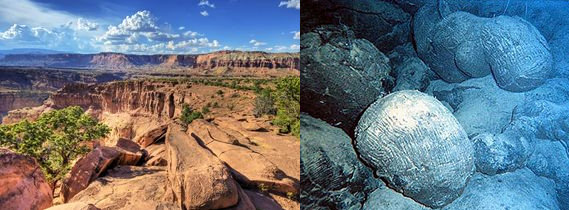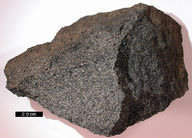3.17: Earth's Crust
- Page ID
- 5355
What do these two photos have in common?
Both of these photos are of Earth's crust. The crust on the left is on the continent. It's what you see and walk on every day. The crust on the right is in the ocean. You may have seen pictures, but to see it in person you need special equipment.
Crust
Crust, mantle, and core differ from each other in chemical composition. It's understandable that scientists know the most about the crust and less about deeper layers. Earth’s crust is a thin, brittle outer shell. The crust is made of rock. This layer is thinner under the oceans and much thicker in mountain ranges.
Oceanic Crust
There are two kinds of crust. Oceanic crust is made of basalt lavas that flow onto the seafloor (Figure below). It is relatively thin, between 5 to 12 kilometers thick (3 - 8 miles). The rocks of the oceanic crust are denser (3.0 g/cm3) than the rocks that make up the continents. Thick layers of mud cover much of the ocean floor.
Gabbro is a dark dense rock that can be found in oceanic crust.
Continental Crust
Continental crust is much thicker than oceanic crust. It is 35 kilometers (22 miles) thick on average, but it varies a lot. Continental crust is made up of many different rocks (Figure below). All three major rock types—igneous, metamorphic, and sedimentary—are found in the crust. On average, continental crust is much less dense (2.7 g/cm3) than oceanic crust. Since it is less dense, it rises higher above the mantle than oceanic crust.
The average composition of continental crust is granite.
Summary
- Oceanic crust is thinner and denser than continental crust.
- Oceanic crust is darker in color and denser (more mafic). Continental crust is lighter in color and density (more felsic).
- Earth's crust is very thin relative to Earth's radius.
Review
- What are the properties of crust?
- Describe the properties of oceanic crust.
- Describe the properties of continental crust.
Explore More
Use this resource to answer the questions that follow.
https://www.sciencemag.org/news/2018/09/watch-hurricane-put-dent-earth-s-crust
- Where did Hurricane Harvey make landfall? How much water did it dump?
- Where did the water go after the storm?
- What happened to Earth’s crust?
- How can scientists determine the weight of the water from Harvey?
- What is depression of crust called?
- Where did the water go after Harvey?
- How long did it take for the water stored on land to dissipate?
- Why will storms strike with increased frequency and ferocity?
- What does the narrator’s mom always say?




